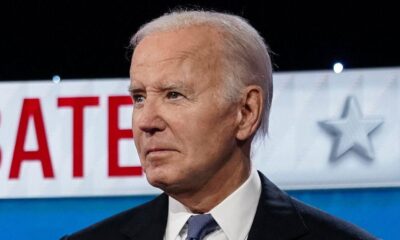Finance
China is leading gold’s record-breaking rally
(Bloomberg) — Gold’s rise to a record high above $2,400 an ounce this year has captivated global markets. China, the world’s largest producer and consumer of the precious metal, is at the center of the extraordinary rise.
Most read from Bloomberg
Worsening geopolitical tensions, including war in the Middle East and Ukraine, and the prospect of lower US interest rates, highlight the value of gold as an investment. But the rally is being fueled by relentless Chinese demand, as retailers, fund investors, futures traders and even the central bank look to bullion as a store of value in uncertain times.
Biggest buyer
China and India typically vie for the title of world’s largest buyer. But that changed last year when Chinese consumption of jewelry, bars and coins rose to record levels. Demand for gold jewelry in China increased by 10%, while in India it fell by 6%. Meanwhile, Chinese investments in bars and coins increased by 28%.
And there is still room for demand growth, says Philip Klapwijk, managing director of Hong Kong-based consultant Precious Metals Insights Ltd. Amid limited investment opportunities in China, the ongoing real estate crisis, volatile stock markets and a weakening yuan are all major factors. driving money into assets considered safer.
“The weight of money available under these circumstances for an asset like gold – and in fact for new buyers coming in – is quite significant,” he said. “There is not much alternative in China. With exchange controls and capital controls you can’t just look at other markets to put your money in.”
Imports jump
Although China mines more gold than any other country, it still needs to import a lot and the quantities are increasing. Over the past two years, foreign purchases totaled more than 2,800 tons – more than all the metal backing exchange-traded funds around the world, or about a third of the U.S. Federal Reserve’s inventories.
Still, the pace of shipments has increased recently. Imports soared in the run-up to the Chinese Lunar New Year, a high season for gifting, and are up 53% in the first two months of the year compared to 2023.
Central bank
The People’s Bank of China has been buying for 17 months in a row, the longest streak ever, as it seeks to diversify its reserves against the dollar and hedge against the currency’s depreciation.
It is the sharpest buyer among a number of central banks that favor gold. The official sector reached near-record levels of the precious metal last year and is expected to keep purchases high through 2024.
Shanghai Premium
It is indicative of gold’s appeal that Chinese demand remains so strong despite record prices and a weaker yuan robbing buyers of purchasing power.
As a major importer, gold buyers in China often have to pay a premium compared to international prices. That rose to $89 per ounce at the beginning of the month. The average over the past year is $35, compared to a historical average of just $7.
Sure, skyrocketing prices are likely to dampen any enthusiasm for precious metals, but the market is proving to be extremely resilient. Chinese consumers have typically snapped up gold when prices have fallen, which has helped set a floor for the market during times of weakness. This is not the case this time, as Chinese appetite helps keep prices at much higher levels.
That suggests the rally is sustainable and gold buyers everywhere should be reassured by growing Chinese demand, said Nikos Kavalis, director of consultancy Metals Focus Ltd.
Chinese authorities, who can be quite hostile to market speculation, are less optimistic. State media has warned investors to be cautious in chasing the rally, while both the Shanghai Gold Exchange and the Shanghai Futures Exchange have raised margin requirements on some contracts to stamp out excessive risk-taking. SHFE’s move followed a rise in daily trading volumes to a five-year high.
ETF flows
A less hectic way to invest in gold is through exchange-traded funds. Money has flowed into gold ETFs in mainland China almost every month since June, according to Bloomberg Intelligence. This is comparable to the large outflow of gold funds in the rest of the world.
Fund inflows have reached $1.3 billion so far this year, compared with $4 billion in outflows from foreign funds. Restrictions on investments in China again play a role here, given the fewer options for Chinese besides domestic real estate and equities.
Chinese demand could continue to rise as investors look to diversify their investments into commodities, BI analyst Rebecca Sin said in a note.
–With help from Jack Wang and Eddie Spence.
Most read from Bloomberg Businessweek
©2024 BloombergLP









